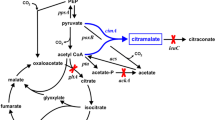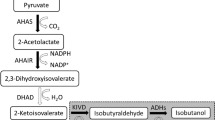Abstract
Objective
Acetyl-CoA is used to produce many valuable metabolites in Escherichia coli. However, acetate overflow is a major shortcoming. Knockout of the global regulator gene, arcA, may solve this problem.
Results
The arcA gene of E. coli BL21(DE3) was knocked out, and the production of phloroglucinol (PG) and 3-hydroxypropionate (3HP), both derived from acetyl-CoA, were used to evaluate its effect. The arcA mutants had higher cell yields and higher glucose utilization efficiencies than the corresponding control strains, and the productions of PG and 3HP were 0.92 g/l and 0.27 g/l, respectively; more than twice that of the control strains. Furthermore, arcA knockout also showed significant repression on formation of acetate, the major byproduct in fermentation. Acetate concentrations were decreased 69.4 % and 87 % by arcA knockout during the production of PG and 3HP, respectively.
Conclusions
The arcA gene knockout is a solution to acetate overflow and may improve production of a wide range of acetyl-CoA-derived metabolites.


Similar content being viewed by others
References
Cao Y, Jiang X, Zhang R, Xian M (2011) Improved phloroglucinol production by metabolically engineered Escherichia coli. Appl Microbiol Biotechnol 9:1545–1552
Chen Y, Daviet L, Schalk M, Siewers V, Nielsen J (2013) Establishing a platform cell factory through engineering of yeast acetyl-CoA metabolism. Metab Eng 15:48–54
Edwards RAKL, Schifferli DM (1998) Improved allelic exchange vectors and their use to analyze 987P fimbria gene expression. Gene 207:149–157
Farmer WR, Liao JC (1997) Reduction of aerobic acetate production by Escherichia coli. Applied and Environmental microbiology 63(8):3205–3210
Kang Z, Geng Y, Xia Y, Kang J, Qi Q (2009) Engineering Escherichia coli for an efficient aerobic fermentation platform. J Biotechnol 144:58–63
Kim HJ, Hou BK, Lee SG, Kim JS, Lee DW, Lee SJ (2013) Genome-wide analysis of redox reactions reveals metabolic engineering targets for D-lactate overproduction in Escherichia coli. Metab Eng 18:44–52
Liu C, Wang Q, Xian M, Ding Y, Zhao G (2013) Dissection of malonyl-coenzyme a reductase of Chloroflexus aurantiacus results in enzyme activity improvement. PLoS One 8:e75554
Lynch AS, Lin E (1996) Transcriptional control mediated by the ArcA two-component response regulator protein of Escherichia coli: characterization of DNA binding at target promoters. J Bacteriol 178:6238–6249
Nikel PI, Pettinari MJ, Ramírez MC, Galvagno MA, Méndez BS (2008) Escherichia coli arcA mutants: metabolic profile characterization of microaerobic cultures using glycerol as a carbon source. J Mol Microbiol Biotechnol 15:48–54
Nizam SA, Zhu J, Ho PY, Shimizu K (2009) Effects of arcA and arcB genes knockout on the metabolism in Escherichia coli under aerobic condition. Biochem Eng J 44:240–250
Perrenoud A, Sauer U (2005) Impact of global transcriptional regulation by ArcA, ArcB, Cra, Crp, Cya, Fnr, and Mlc on glucose catabolism in Escherichia coli. J Bacteriol 187:3171–3179
Rathnasingh C, Raj SM, Jo JE, Park S (2009) Development and evaluation of efficient recombinant Escherichia coli strains for the production of 3-hydroxypropionic acid from glycerol. Biotechnol Bioeng 104:729–739
Rathnasingh C, Raj SM, Lee Y, Catherine C, Ashok S, Park S (2012) Production of 3-hydroxypropionic acid via malonyl-CoA pathway using recombinant Escherichia coli strains. J Biotechnol 157:633–640
Singh IP, Sidana J, Bansal P, Foley WJ (2009) Phloroglucinol compounds of therapeutic interest: global patent and technology status. Expert Opin 19:847–866
Vemuri GN, Eiteman MA, Altman E (2006) Increased recombinant protein production in Escherichia coli strains with overexpressed water-forming NADH oxidase and a deleted ArcA regulatory protein. Biotechnol Bioeng 94:538–542
Waegeman H, Maertens J, Beauprez J, De Mey M, Soetaert W (2012) Effect of iclR and arcA deletions on physiology and metabolic fluxes in Escherichia coli BL21 (DE3). Biotechnol Lett 34:329–337
Wong MS, Wu S, Causey TB, Bennett GN, San KY (2008) Reduction of acetate accumulation in Escherichia coli cultures for increased recombinant protein production. Metab Eng 10:97–108
Zha W, Rubin-Pitel SB, Zhao H (2008) Exploiting genetic diversity by directed evolution: molecular breeding of type III polyketide synthases improves productivity. Mol BioSyst 4:246–248
Acknowledgments
This work was supported by100-Talent Project of CAS (to GZ), Natural Science Foundation of Shandong Province (ZR2013EMZ002), National Natural Science Foundation of China (21376255), Taishan Scholars Climbing Program of Shandong(No.tspd20150210)and Key Program of CAS (KGZD-EW-606-1-3).
Author information
Authors and Affiliations
Corresponding authors
Rights and permissions
About this article
Cite this article
Liu, M., Yao, L., Xian, M. et al. Deletion of arcA increased the production of acetyl-CoA-derived chemicals in recombinant Escherichia coli . Biotechnol Lett 38, 97–101 (2016). https://doi.org/10.1007/s10529-015-1953-7
Received:
Accepted:
Published:
Issue Date:
DOI: https://doi.org/10.1007/s10529-015-1953-7




